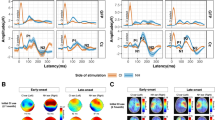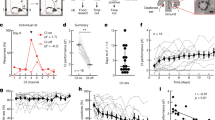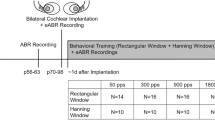Abstract
Cochlear implants have provided hearing to more than 120,000 deaf people. Recent surgical developments include direct electrical stimulation of the brain, bilateral implants and implantation in children less than 1 year old. However, research is beginning to refocus on the role of the brain in providing benefits to implant users. The auditory system is able to use the highly impoverished input provided by implants to interpret speech, but this only works well in those who have developed language before their deafness or in those who receive their implant at a very young age. We discuss recent evidence suggesting that developing the ability of the brain to learn how to use an implant may be as important as further improvements of the implant technology.
This is a preview of subscription content, access via your institution
Access options
Subscribe to this journal
Receive 12 print issues and online access
$209.00 per year
only $17.42 per issue
Buy this article
- Purchase on Springer Link
- Instant access to full article PDF
Prices may be subject to local taxes which are calculated during checkout




Similar content being viewed by others
References
Spahr, A.J. & Dorman, M.F. Performance of subjects fit with the Advanced Bionics CII and Nucleus 3G cochlear implant devices. Arch. Otolaryngol. Head Neck Surg. 130, 624–628 (2004).
Krueger, B. et al. Performance groups in adult cochlear implant users: speech perception results from 1984 until today. Otol. Neurotol. 29, 509–512 (2008).
Tallal, P. et al. Language comprehension in language-learning impaired children improved with acoustically modified speech. Science 271, 81–84 (1996).
Levi, D.M. & Li, R.W. Improving the performance of the amblyopic visual system. Phil. Trans. R. Soc. Lond. B Biol. Sci. 364, 399–407 (2009).
Henderson Sabes, J. & Sweetow, R.W. Variables predicting outcomes on listening and communication enhancement (LACE) training. Int. J. Audiol. 46, 374–383 (2007).
Fu, Q.J. & Galvin, J.J., III. Maximizing cochlear implant patients' performance with advanced speech training procedures. Hear. Res. 242, 198–208 (2008).
Eisen, M.D. Djourno, Eyries, and the First implanted electrical neural stimulator to restore hearing. Otol. Neurotol. 24, 500–506 (2003).
Shannon, R.V. & Otto, S.R. Psychophysical measures from electrical stimulation of the human cochlear nucleus. Hear. Res. 47, 159–168 (1990).
Shannon, R.V. et al. Auditory brainstem implant. II. Postsurgical issues and performance. Otolaryngol. Head Neck Surg. 108, 634–642 (1993).
Otto, S.R., Brackmann, D.E., Hitselberger, W.E., Shannon, R.V. & Kuchta, J. The multichannel auditory brainstem implant update: performance in 61 patients. J. Neurosurg. 96, 1063–1071 (2002).
Otto, S.R. et al. Audiological outcomes with the penetrating electrode auditory brainstem implant. Otol. Neurotol. 29, 1147–1154 (2008).
Colletti, V. & Shannon, R.V. Open set speech perception with auditory brainstem implant? Laryngoscope 115, 1974–1978 (2005).
Colletti, V. et al. The first successful case of hearing produced by electrical stimulation of the human midbrain. Otol. Neurotol. 28, 39–43 (2007).
Lenarz, T., Lim, H.H., Reuter, G., Patrick, J.F. & Lenarz, M. The auditory midbrain implant: a new auditory prosthesis for neural deafness-concept and device description. Otol. Neurotol. 27, 838–843 (2006).
Tucci, D.L., Born, D.E. & Rubel, E.W. Changes in spontaneous activity and CNS morphology associated with conductive and sensorineural hearing loss in chickens. Ann. Otol. Rhinol. Laryngol. 96, 343–350 (1987).
Parks, T.N., Rubel, E.W., Popper, A.N. & Fay, R.R. Plasticity of the Auditory System (Springer, New York, 2004).
Tierney, T.S., Russell, F.A. & Moore, D.R. Susceptibility of developing cochlear nucleus neurons to deafferentation-induced death abruptly ends just before the onset of hearing. J. Comp. Neurol. 378, 295–306 (1997).
Moore, D.R. Trophic influences of excitatory and inhibitory synapses on neurones in the auditory brainstem. Neuroreport 3, 269–272 (1992).
Harris, J.A., Iguchi, F., Seidl, A.H., Lurie, D.I. & Rubel, E.W. Afferent deprivation elicits a transcriptional response associated with neuronal survival after a critical period in the mouse cochlear nucleus. J. Neurosci. 28, 10990–11002 (2008).
Mossop, J.E., Wilson, M.J., Caspary, D.M. & Moore, D.R. Down-regulation of inhibition following unilateral deafening. Hear. Res. 147, 183–187 (2000).
Eggermont, J.J. Role of auditory cortex in noise- and drug-induced tinnitus. Am. J. Audiol. 17, S162–S169 (2008).
Dahmen, J.C. & King, A.J. Learning to hear: plasticity of auditory cortical processing. Curr. Opin. Neurobiol. 17, 456–464 (2007).
de Villers-Sidani, E., Chang, E.F., Bao, S. & Merzenich, M.M. Critical period window for spectral tuning defined in the primary auditory cortex (A1) in the rat. J. Neurosci. 27, 180–189 (2007).
Noreña, A.J., Gourévitch, B., Aizawa, N. & Eggermont, J.J. Spectrally enhanced acoustic environment disrupts frequency representation in cat auditory cortex. Nat. Neurosci. 9, 932–939 (2006).
Kamke, M.R., Brown, M. & Irvine, D.R.F. Basal forebrain cholinergic input is not essential for lesion-induced plasticity in mature auditory cortex. Neuron 48, 675–686 (2005).
Polley, D.B., Steinberg, E.E. & Merzenich, M.M. Perceptual learning directs auditory cortical map reorganization through top-down influences. J. Neurosci. 26, 4970–4982 (2006).
Hyson, R.L. & Rubel, E.W. Transneuronal regulation of protein synthesis in the brain stem auditory system of the chick requires synaptic activation. J. Neurosci. 9, 2835–2845 (1989).
Leake, P.A., Stakhovskaya, O., Hradek, G.T. & Hetherington, A.M. Factors influencing neurotrophic effects of electrical stimulation in the deafened developing auditory system. Hear. Res. 242, 86–99 (2008).
Fallon, J.B., Irvine, D.R. & Shepherd, R.K. Cochlear implant use following neonatal deafness influences the cochleotopic organization of the primary auditory cortex in cats. J. Comp. Neurol. 512, 101–114 (2009).
Kral, A., Tillein, J., Heid, S., Klinke, R. & Hartmann, R. Cochlear implants: cortical plasticity in congenital deprivation. Prog. Brain Res. 157, 283–313 (2006).
Moore, C.M., Vollmer, M., Leake, P.A., Snyder, R.L. & Rebscher, S.J. The effects of chronic intracochlear electrical stimulation on inferior colliculus spatial representation in adult deafened cats. Hear. Res. 164, 82–96 (2002).
Brown, S.D., Hardisty-Hughes, R.E. & Mburu, P. Quiet as a mouse: dissecting the molecular and genetic basis of hearing. Nat. Rev. Genet. 9, 277–290 (2008).
Eisenberg, L.S., Shannon, R.V., Martinez, A.S., Wygonski, J. & Boothroyd, A. Speech recognition with reduced spectral cues as a function of age. J. Acoust. Soc. Am. 107, 2704–2710 (2000).
Kuhl, P.K. Early language acquisition: cracking the speech code. Nat. Rev. Neurosci. 5, 831–843 (2004).
Maurer, D., Lewis, T.L. & Mondloch, C.J. Plasticity of the visual system. in The Handbook of Developmental Cognitive Neuroscience 2nd edn. (Nelson, C.A. & Luciana, M., eds.) 415–437 (MIT Press, Boston, 2008).
Knudsen, E.I. Sensitive periods in the development of the brain and behavior. J. Cogn. Neurosci. 16, 1412–1425 (2004).
Svirsky, M.A., Robbins, A.M., Kirk, K.I., Pisoni, D.B. & Miyamoto, R.T. Language development in profoundly deaf children with cochlear implants. Psychol. Sci. 11, 153–158 (2000).
Sharma, A., Gilley, P.M., Dorman, M.F. & Baldwin, R. Deprivation-induced cortical reorganization in children with cochlear implants. Int. J. Audiol. 46, 494–499 (2007).
Galvin, J.J., III., Fu, Q.J. & Shannon, R.V. The importance of temporal envelope and fine structure cues for speech and music: lessons from cochlear implants. Ann. N Y Acad. Sci. (in the press).
Vongpaisal, T., Trehub, S.E. & Schellenberg, E.G. Song recognition by children and adolescents with cochlear implants. J. Speech Lang. Hear. Res. 49, 1091–1103 (2006).
Moore, D.R., Ferguson, M.A., Halliday, L.F. & Riley, A. Frequency discrimination in children: perception, learning and attention. Hear. Res. 238, 147–154 (2008).
Shannon, R.V., Zeng, F.G., Kamath, V., Wygonski, J. & Ekelid, M. Speech recognition with primarily temporal cues. Science 270, 303–304 (1995).
Friesen, L.M., Shannon, R.V., Baskent, D. & Wang, X. Speech recognition in noise as a function of the number of spectral channels: comparison of acoustic hearing and cochlear implants. J. Acoust. Soc. Am. 110, 1150–1163 (2001).
Davis, M.H., Johnsrude, I.S., Hervais-Adelman, A., Tayler, K. & McGettingan, C. Lexical information drives perceptual learning of distorted speech: evidence from the comprehension of noise-vocoded sentences. J. Exp. Psychol. Gen. 134, 222–241 (2005).
Stacey, P.C. & Summerfield, A.Q. Comparison of word-, sentence- and phoneme-based training strategies in improving the perception of spectrally distorted speech. J. Speech Lang. Hear. Res. 51, 526–538 (2008).
Faulkner, A., Rosen, S. & Norman, C. The right information may matter more than frequency-place alignment: simulations of frequency-aligned and upward shifting cochlear implant processors for a shallow electrode array insertion. Ear Hear. 27, 139–152 (2006).
Loebach, J.L., Bent, T. & Pisoni, D.B. Multiple routes to the perceptual learning of speech. J. Acoust. Soc. Am. 124, 552–561 (2008).
Moore, D.R., Halliday, L.F. & Amitay, S. Use of auditory learning to manage listening problems in children. Phil. Trans. R. Soc. Lond. B 364, 409–420 (2009).
Moore, D.R., Rosenberg, J.F. & Coleman, J.S. Discrimination training of phonemic contrasts enhances phonological processing in mainstream school children. Brain Lang. 94, 72–85 (2005).
Wright, B.A. & Zhang, Y. A review of the generalization of auditory learning. Phil. Trans. R. Soc. Lond. B 364, 301–311 (2009).
Author information
Authors and Affiliations
Corresponding author
Ethics declarations
Competing interests
David Moore is the founder, a director and a shareholder of MindWeavers PLC, a company that makes and sells software for enhancing listening and cognitive processing.
Rights and permissions
About this article
Cite this article
Moore, D., Shannon, R. Beyond cochlear implants: awakening the deafened brain. Nat Neurosci 12, 686–691 (2009). https://doi.org/10.1038/nn.2326
Published:
Issue Date:
DOI: https://doi.org/10.1038/nn.2326
This article is cited by
-
Locus coeruleus activity improves cochlear implant performance
Nature (2023)
-
Training spatial hearing in unilateral cochlear implant users through reaching to sounds in virtual reality
European Archives of Oto-Rhino-Laryngology (2023)
-
Long-term changes in cortical representation through perceptual learning of spectrally degraded speech
Journal of Comparative Physiology A (2023)
-
Electrophysiological assessment of temporal envelope processing in cochlear implant users
Scientific Reports (2020)
-
Bacomics: a comprehensive cross area originating in the studies of various brain–apparatus conversations
Cognitive Neurodynamics (2020)



